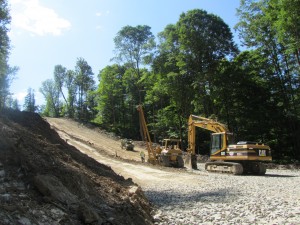PUC Chairman advocates increased safety controls at compressor stations
-
Laura Legere

Kim Paynter / WHYY/Newsworks
Bulldozers clear land for a Marcellus Shale gas pipeline in Northeast Pennsylvania.
Pennsylvania Public Utility Commission Chairman Robert Powelson encouraged pipeline companies to use real-time monitoring and increase staffing near compressor stations during a pipeline conference in Philadelphia on Wednesday.
According to the Scranton Times-Tribune, the regulator described the rapid expansion of pipelines in Pennsylvania and the agency’s changing role in overseeing the development since the adoption of the Gas and Hazardous Liquids Pipeline Act, also known as Act 127, in 2011:
Mr. Powelson said the act has given the commission adequate tools to enforce pipeline safety regulations, but “it’s still a work in progress.”
He would like the industry to use real-time monitoring on its compressor stations and put more employees near compressor station sites to deal with potential incidents.
“There should be an on-site person that’s able to collaborate with and coordinate with us,” Mr. Powelson said. “People want peace of mind that within a couple-hour period, there’s going to be people out there deployed.”
Mr. Powelson also talked about the challenge of finding trained pipeline inspectors to add to the roster of nine inspectors the agency currently employs. According to the newspaper, Pennsylvania hosts many miles of pipeline to monitor:
Pennsylvania has more than 68,000 total pipeline miles, made up of 46,000 miles of natural gas distribution lines, 10,004 miles of lines that gather gas from wellheads, 9,485 [miles of] transmission lines and 2,777 miles of hazardous liquids pipelines.
Meanwhile, a watchdog group issued a report this week finding that federal pipeline safety regulators spend more time attending industry conferences than they do attending to safety incidents.
The agency, the Pipeline and Hazardous Materials Safety Administration, defended its record, saying 80 percent of its pipeline safety staff’s time last year was spent conducting safety-related activities, like inspections and investigations.
















